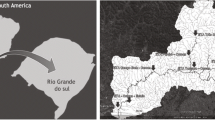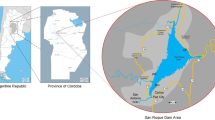Abstract
The capability of faecal indicator bacteria (FIB) to be environmental in origin and the deficient specificity of markers can mean uncertain outcomes when just a single marker is distinguished. This can give a bogus thought regarding water quality. A water quality analysis and the correlation between FIB, multiple physiochemical parameters and a viral marker in recreational waters were studied. For water concentration, carefully validated virus filtration techniques were used coupled with PCR-based assays for virus quantification. Around 32.0% of analysed surface water samples were positive for human adenovirus (HAdV, qPCR), 16.0% for bovine adenovirus (BAdV, nested PCR) and 11.0% for porcine adenovirus (PAdV, qPCR). For all the types of the adenoviruses, detection frequencies were not significantly different except for HAdV that showed higher frequency in water samples from tehsil Ludhiana. Only a sporadic significant correlation was observed with the few components; there was no constant, stable correlation between the microbiological and physiochemical parameters. Although both canals and river showed a stable and significant positive correlation between bacteriological parameters (coliform and enterococci) and between biological oxygen demand (BOD) and chemical oxygen demand (COD), regression analysis revealed no significant correlations between concentration of enterococci count to a concentration of AdVs, unlike coliform that showed sporadic but significant correlation with PAdV and no correlation with HAdVs/BAdVs. On principal component analysis, the first factor had strong positive loadings on BOD, COD, total dissolved solids (TDS), turbidity and PAdV and is largely a pollution loading factor which is also supported by their mutual cluster in cluster analysis. Factor 2 had strong loading on enterococci/coliform count due to the natural quality of water and domestic waste and factor 3 had loading on HAdV. This factor shows the impact of human activities overwhelmed in the catchment area of the canals and river. Hence, a significant level of certainty on the contamination source can be acquired if more than one marker is distinguished. Our study thus gives a case of how quantifying both physiochemical, FIB and adenoviral markers in surface water can improve water quality evaluation and help tailor CPCB -India programs for impaired water bodies in the future.






Similar content being viewed by others
References
Albinana-Gimenez, N., Miagostovich, M. P., Calqua, B., Huguet, J. M., Matia, L., & Girones, R. (2009). Analysis of adenoviruses and polyomaviruses quantified by qPCR as indicators of water quality in source and drinking-water treatment plants. Water Research, 43, 2011–2019.
Ali, S., Hussain, S., Abbas, Q., Hussain, M., Ali, W., & Akber, M. et al. (2014). Water quality assessment of Gilgit river, using fecal and total coliform as indicators. Journal Of Biodiversity And Environmental Sciences, 5(4), 343–347.
Bora, M., & Goswami, D. (2016). Water quality assessment in terms of water quality index (WQI): A case study of the Kolong River, Assam, India. Applied Water Science, 7(6), 3125–3135. https://doi.org/10.1007/s13201-016-0451-y.
Bortagaray, V., Lizasoain, A., Piccini, C., Gillman, L., Berois, M., Pou, S., et al. (2019). Microbial source tracking analysis using viral indicators in Santa Lucía and Uruguay Rivers, Uruguay. Food And Environmental Virology, 11(3), 259–267. https://doi.org/10.1007/s12560-019-09384-2.
Choi, S., & Jiang, S. C. (2005). Real-time PCR quantification of human adenoviruses in urban rivers indicates genome prevalence but low infectivity. Applied and Environmental Microbiology, 71(11), 7426–7433.
Central Pollution Control Board (CPCB). (2002). Water quality in India – status and trend (1990 - 2001) (pp. 1–20) Delhi: Ministry of Environment & forests, Govt. of India.
Central Pollution Control Board (CPCB). (2008). Guidelines for water quality management. Parivesh Bhawan, East Arjun Nagar, Delhi.
Central Pollution Control Board (CPCB). (2011). Status of water quality in India—2011. New Delhi: Central Pollution Control Board (Ministry of Environment and Forestry) http://www.cpcb.nic.in
Central Pollution Control Board (CPCB). (2015). River stretches for restoration of water quality. New Delhi: Central Pollution Control Board (Ministry of Environment, Forest and Climate change) report.
Colford, J.M., Wade, T.J., Schiff, K.C., Wright, C.C., Griffith, J.F., Sandhu, S.K. et al. (2007). Water quality indicators and the risk of illness at beaches with nonpoint sources of fecal contamination. Epidemiology, 18(1), 27–35.
Das Kangabam, R., Bhoominathan, S., Kanagaraj, S., & Govindaraju, M. (2017). Development of a water quality index (WQI) for the Loktak Lake in India. Applied Water Science, 7(6), 2907–2918.
Du, X., Shao, F., Wu, S., Zhang, H., & Xu, S. (2017). Water quality assessment with hierarchical cluster analysis based on Mahalanobis distance. Environmental Monitoring and Assessment, 189(7), 335.
Dwight, R.H., Baker, D.B., Semenza, J.C., & Olson, B.H. (2004). Health effects associated with recreational coastal water use: Urban versus Rural California. American Journal of Public Health, 94, 565–567.
U.S. Environmental Protection Agency (EPA) (1997) Method 1600: membrane filter test method for enterococci in water. EPA/821/R-97/004. US Environmental Protection Agency, Washington, DC.
Farkas, K., Cooper, D., McDonald, J., Malham, S., de Rougemont, A., & Jones, D. (2018). Seasonal and spatial dynamics of enteric viruses in wastewater and in riverine and estuarine receiving waters. Science of the Total Environment, 634, 1174–1183. https://doi.org/10.1016/j.scitotenv.2018.04.038.
Hamner, S., Tripathi, A., Mishra, R., Bouskill, N., Broadaway, S., & Pyle Band Ford, T. (2007). The role of water use patterns and sewage pollution in incidence of water-borne/enteric diseases along the Ganges river in Varanasi, India. International Journal Of Environmental Health Research, 16(2), 113–132.
Haramoto, E., Kitajima, M., Katayama, H., & Ohgaki, S. (2010). Real-time PCR detection of adenoviruses, polyomaviruses and torque Teno viruses in river water in Japan. Water Research, 44(6), 1747–1752.
Hundesa, A., Maluquer de Motes, C., Bofill-Mas, S., Albinana-Gimenez, N., & Girones, R. (2006). Identification of human and animal adenoviruses and polyomaviruses for determination of sources of faecal contamination in the environment. Applied and Environmental Microbiology, 72(12), 7886–7893.
Kirschner, A., Reischer, G., Jakwerth, S., Savio, D., Ixenmaier, S., Toth, E., et al. (2017). Multiparametric monitoring of microbial faecal pollution reveals the dominance of human contamination along the whole Danube River. Water Research, 124, 543–555. https://doi.org/10.1016/j.watres.2017.07.052.
Kumar, V., Sharma, A., Chawla, A., Bhardwaj, R., & Thukral, A. (2016). Water quality assessment of river Beas, India, using multivariate and remote sensing techniques. Environmental Monitoring and Assessment, 188(3), 137.
Kumar, M., Ramanathan, A., Tripathi, R., Farswan, S., Kumar, D., & Bhattacharya, P. (2018). A study of trace element contamination using multivariate statistical techniques and health risk assessment in groundwater of Chhaprola Industrial Area, Gautam Buddha Nagar, Uttar Pradesh, India. Chemosphere, 166, 135–145.
Lee, G. C., Jheong, W. H., Kim, M. J., Choi, D. H., & Baik, K. H. (2013). A 5-year survey (2007–2011) of enteric viruses in Korean aquatic environments and the use of coliforms as viral indicators. Microbiology and Immunology, 57, 46–53.
Liang, L., Goh, S.G., Vergara, G.G.R.V., Fang, H.M., Rezaeinejad, S., Chang, S.Y., Bayen, S., Lee, W.A., Sobsey, M.D., Rose, J.B., & Gina, K.Y.H. (2015). Alternative fecal indicators and their empirical relationships with enteric viruses, Salmonella entericaand Pseudomonas aeruginosa in surface waters of a tropical urban catchment. Applied and Environmental Microbiology, 81(3), 850–860.
McCulloch, K. J. (2015). Thesis: Analysis of the relationship between water quality parameters and stream sediment with faecal bacteria in hidden creeks, Rock Hill, SC. paper 14, Winthrop University. http://digitalcommons.winthrop. edu/graduate theses.
Patel, K., Shukla, A., Tripathi, A., & Hoffmann, P. (2002). Heavy metal concentrations of precipitation in East Madhya Pradesh of India. Water, Air and Soil Pollution, 130(1/4), 463–468.
Ponsadailakshmi, S., Sankari, S., Prasanna, S., & Madhurambal, G. (2018). Evaluation of water quality suitability for drinking using drinking water quality index in Nagapattinam district, Tamil Nadu in Southern India. Groundwater for Sustainable Development, 6, 43–49. https://doi.org/10.1016/j.gsd.2017.10.005.
Rosemond, S., Duro, D., & Dubé, M. (2009). Comparative analysis of regional water quality in Canada using the Water Quality Index. Environmental Monitoring And Assessment, 156(1-4), 223–240.
Schriewer, A., Wuertz, S., Misra, P., Clasen, T., Panigrahi, P., Jenkins, M., & Odagiri, M. (2015). Human and animal fecal contamination of community water sources, stored drinking water and hands in rural India measured with validated microbial source tracking assays. The American Journal of Tropical Medicine and Hygiene, 93(3), 509–516.
Setia, R., Dhaliwal, S., Kumar, V., Singh, R., Kukal, S., & Pateriya, B. (2020). Impact assessment of metal contamination in surface water of Sutlej River (India) on human health risks. Environmental Pollution, 265, 114907. https://doi.org/10.1016/j.envpol.2020.114907.
Sun, W., Xia, C., Xu, M., Guo, J., & Sun, G. (2016). Application of modified water quality indices as indicators to assess the spatial and temporal trends of water quality in the Dongjiang River. Ecological Indicators, 66, 306–312.
Tripathi, M., & Singal, S. (2019). Use of principal component analysis for parameter selection for development of a novel water quality index: a case study of river ganga India. Ecological Indicators, 96, 430–436. https://doi.org/10.1016/j.ecolind.2018.09.025.
U.S. Environmental Protection Agency (2002) Method 1603: Escherichia coli in water by membrane filtration using modified membrane-thermotolerant Escherichia coli agar (modified mTEC). EPA/821/R-02/023. US Environmental Protection Agency, Washington, DC.
Vecchia, D. A., Rigotto, C., Staggemeier, R., Solimon, C. M., Gil de Souza, F., Henzel, A., & Santos, L. E. (2015). Surface water quality in the Sinos river basin, in Southern Brazil: tracking microbiological contamination and correlation with physiochemical parameters. Environmental Science and Pollution Research, 22(13), 9899–9811.
Waso, M., Khan, S., & Khan, W. (2018). Microbial source tracking markers associated with domestic rainwater harvesting systems: correlation to indicator organisms. Environmental Research, 161, 446–455.
Wyn-Jones, A. P., Carducci, A., Cook, N., D’Agostino, M., Divizia, M., Fleischer, J., Gantzer, C., Gawler, A., Girones, R., Holler, C., de Roda Husman, A. M., Kay, D., Kozyra, I., Lopez-Pila, J., Muscillo, M., Nascimento, M. S., Papageorgiou, G., Rutjes, S., Sellwood, J., Szewzyk, R., & Wyer, M. (2011). Surveillance of adenoviruses and noroviruses in European recreational waters. Water Research, 45(3), 1025–1038.
Yahya, M., Blanch, A. R., Meijer, W. G., Antoniou, K., Hmaied, F., & Ballesté, E. (2017). Comparison of the performance of different microbial source tracking markers among European and North African Regions. Journal of Environmental Quality, 46(4), 760.
Zehra, A. (2018). Molecular assays targeting species-specific adenoviruses in different aquatic environments and their application for library-independent microbial source tracking (PhD Dissertation). Guru Angad Dev Veterinary and Animal Sciences University (GADVASU), Ludhiana-India.
Zeinalzadeh, K., & Rezaei, E. (2017). Determining spatial and temporal changes of surface water quality using principal component analysis. Journal Of Hydrology: Regional Studies, 13, 1–10.
Acknowledgements
We thank the Farmers Commission Punjab and GADVASU Ludhiana (India) for supporting Dr. Simranpreet Kaur’s visit to CSIRO Land and Water Flagship, Brisbane, Australia. We also thank Dr. Sachin Kumar (IIT Guwahati) for providing Human Adenovirus standard for this study.
Funding
This work was financially supported by School of Public Health and Zoonoses, Guru Angad Dev Veterinary Animal Sciences University (GADVASU), Punjab, India.
Author information
Authors and Affiliations
Contributions
Zehra A.—lab work, data analysis and manuscript writing; Kaur S.—guidance and manuscript editing; Kaur S., Singh R. and Gill JPS.— technical program of work.
Corresponding author
Ethics declarations
Conflict of Interest
The authors declare that they have no conflict of interest.
Ethics Approval
Not applicable.
Additional information
Publisher’s Note
Springer Nature remains neutral with regard to jurisdictional claims in published maps and institutional affiliations.
Electronic supplementary material
ESM 1
(DOCX 238 kb)
Rights and permissions
About this article
Cite this article
Zehra, A., Kaur, S., Singh, R. et al. Surface Water Quality in Punjab, India: Tracking Human and Farm Animal-Specific Adenoviral Contamination and Correlation with Microbiological and Physiochemical Parameters. Water Air Soil Pollut 231, 534 (2020). https://doi.org/10.1007/s11270-020-04892-5
Received:
Accepted:
Published:
DOI: https://doi.org/10.1007/s11270-020-04892-5




